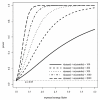The synergy factor: a statistic to measure interactions in complex diseases
- PMID: 19527493
- PMCID: PMC2706251
- DOI: 10.1186/1756-0500-2-105
The synergy factor: a statistic to measure interactions in complex diseases
Abstract
Background: One challenge in understanding complex diseases lies in revealing the interactions between susceptibility factors, such as genetic polymorphisms and environmental exposures. There is thus a need to examine such interactions explicitly. A corollary is the need for an accessible method of measuring both the size and the significance of interactions, which can be used by non-statisticians and with summarised, e.g. published data. The lack of such a readily available method has contributed to confusion in the field.
Findings: The synergy factor (SF) allows assessment of binary interactions in case-control studies. In this paper we describe its properties and its novel characteristics, e.g. in calculating the power to detect a synergistic effect and in its application to meta-analyses. We illustrate these functions with real examples in Alzheimer's disease, e.g. a meta-analysis of the potential interaction between a BACE1 polymorphism and APOE4: SF = 2.5, 95% confidence interval: 1.5-4.2; p = 0.0001.
Conclusion: Synergy factors are easy to use and clear to interpret. Calculations may be performed through the Excel programmes provided within this article. Unlike logistic regression analysis, the method can be applied to datasets of any size, however small. It can be applied to primary or summarised data, e.g. published data. It can be used with any type of susceptibility factor, provided the data are dichotomised. Novel features include power estimation and meta-analysis.
Figures



References
Grants and funding
LinkOut - more resources
Full Text Sources

